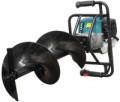Engine size
The working volume of the motor-drill engine.
A larger volume (with the same type of internal combustion engine, see above), on the one hand, increases power, on the other hand, increases fuel consumption. However, in general, this parameter is a reference, and when choosing it is worth paying attention to more practically significant indicators — power, speed, gear ratio, etc.
Power
Engine power of the motor drill in horsepower. Horsepower is traditionally used to denote the power of internal combustion engines. 1 HP approximately equal to 735 watts.
Power is one of the key parameters for any motor auger: the higher it is, the higher torque can be achieved on the drive shaft, the thicker augers can be used with the unit and the better it is suitable for complex work and “heavy” soils. On the other hand, high power significantly affects the price, dimensions and weight of the engine. Therefore, manufacturers choose this parameter based on the price category and general purpose of the tool.
The most modest engines, about 0.8 – 1.5 hp, are installed in power drills (see "Type") — for such devices, high power is not needed, but light weight and compactness, on the contrary, are critical. For motor drills, indicators are 1.6 – 3 hp. correspond to the entry level, 3 – 5 hp. — medium, and in the most powerful models, motors of 7 – 8 hp are installed, which makes it possible to work with screws with a diameter of half a metre or more. At the same time, note that units of the same power may differ in screw diameter and other performance characteristics.
Power
Engine power of a motor drill in kilowatts. Watts (kilowatts) are a common unit of power, and this unit is also used for gasoline engines along with horsepower (see above).
Power is one of the key parameters for any motor auger: the
more powerful the engine, the higher torque can be achieved on the drive shaft, the thicker augers can be used with the unit and the better it is suitable for complex work and “heavy” soils. On the other hand, high power significantly affects the price, dimensions and weight of the engine. Therefore, manufacturers choose this parameter based on the price category and general purpose of the tool.
Indicators of 0.6 – 1.2 kW are typical for the most modest engines, these are mainly equipped with power drills (see "Type"). In entry-level motor drills, more powerful units are used, by 1.2 – 2.2 kW, the average class corresponds to an indicator of 2.3 – 3.7 kW, and in the most solid devices, the power can reach 5.5 – 6 kW. Note that units of the same power may differ in screw diameter and other performance characteristics.
No load speed
The speed given out by the motor drill engine at idle, with the throttle fully released. In this mode, the drive shaft, usually, does not rotate (the automatic clutch turns it on only when the speed increases), so this parameter has no direct practical significance. At the same time, it allows you to evaluate the engine speed range and some of its features; see "Maximum RPM" for details.
Fuel tank capacity
The volume of the fuel tank installed in the drill.
A larger tank allows you to work longer without refueling, but it significantly affects the weight of the tool. Given the peculiarities of the operation of motor drills, in fact it is easier to take breaks for refueling than to keep a large supply of fuel in the unit itself. Therefore, tank volumes are usually small, only in some high-power models this parameter exceeds 2 liters. At the same time, manufacturers take into account fuel consumption and select tanks in such a way that breaks do not have to be taken too often.
Max. length
The maximum length of the drill (auger) or drill with which the tool is able to work normally; in fact, this is the maximum drilling depth available when using this model. Note that some models allow, if necessary, the use of longer drills, due to some tricks (you can read more about them in special sources); however, this possibility is far from being available everywhere, and when choosing, it is worth proceeding precisely from the length claimed by the manufacturer.
Included drill diameter
The diameter of the working nozzle supplied together with the motor drill "out of the box". A drill or drill should be selected according to this parameter based on the maximum diameter of the required holes, as well as the penetration depth of the working tool.
Weight
Nominal weight of the drill. Usually, the weight is indicated "dry", without fuel in the tank, and also without taking into account the auger or other working attachment. However, in some models, originally equipped with drills, the weight may be given for the tool with the nozzle installed.
According to this indicator, one can evaluate the general class of the tool: powerful engines inevitably turn out to be heavy, respectively, the heavier the motor drill, the more powerful it is, usually. A massive unit is more difficult to hold (and models weighing from 20 kg are initially made for two operators), but a large weight has its advantages — the tool gets more stable and less prone to vibrations.

